SEO
How to Execute the Skyscraper Technique (And Get Results)

In 2015, Brian Dean revealed a brand-new link building strategy. He called it the Skyscraper Technique.
With over 10,000 backlinks since the post was published, it’s fair to say that the Skyscraper Technique took the world by storm in 2015. But what is it exactly, how can you implement it, and can you still get results with this technique in 2023?
Let’s get started.
The Skyscraper Technique is a link building strategy where you improve existing popular content and replicate the backlinks.
Brian named it so because in his words, “It’s human nature to be attracted to the best. And what you’re doing here is finding the tallest ‘skyscraper’ in your space… and slapping 20 stories to the top of it.”
Here’s how the technique works:
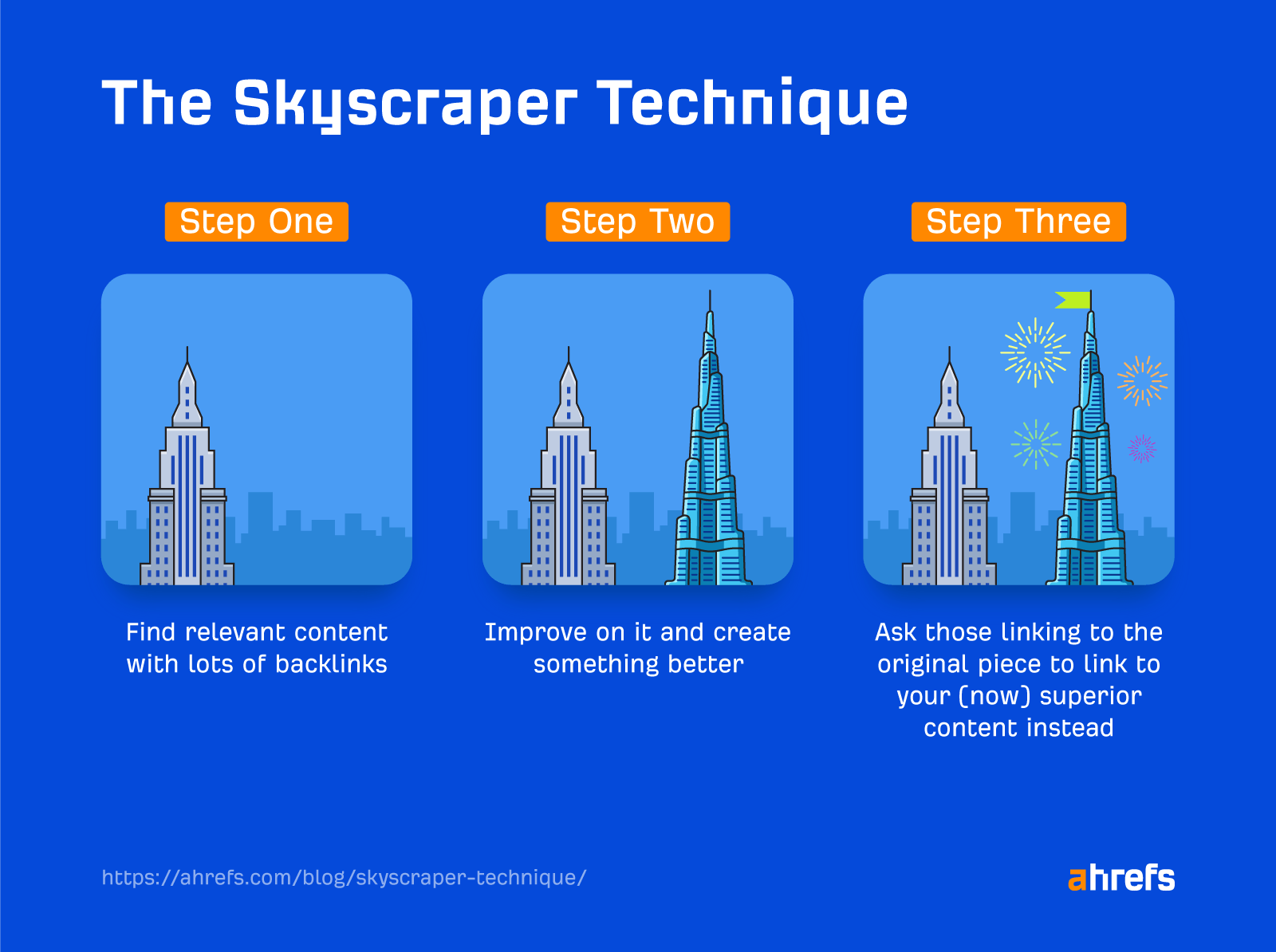
Follow these three steps to execute the Skyscraper Technique.
1. Find relevant content with lots of backlinks
There are three methods to find relevant pages with plenty of links:
Use Site Explorer
Enter a popular site into Ahrefs’ Site Explorer. Next, go to the Best by backlinks report.
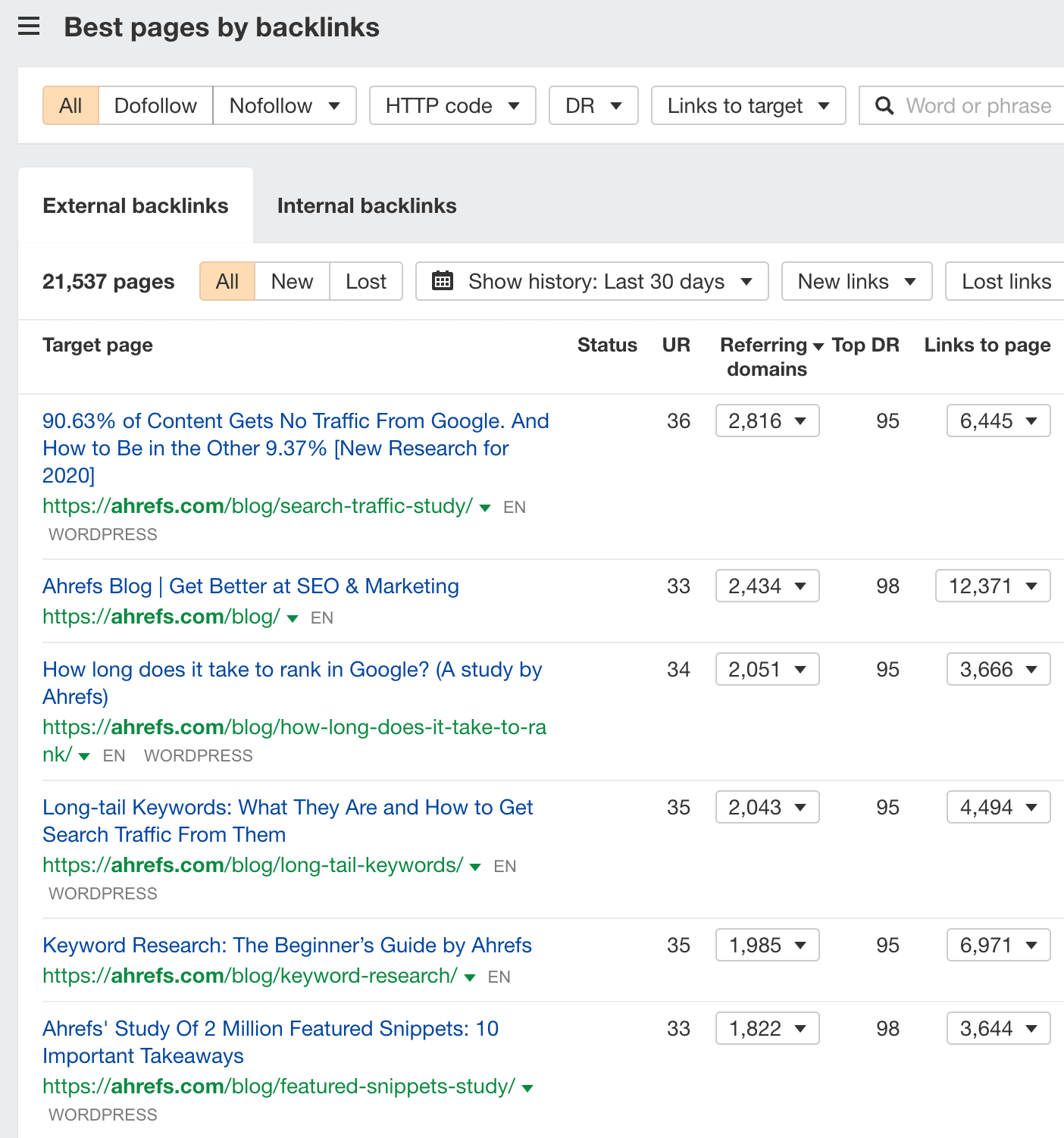
This report shows you a list of pages from the site with the highest number of referring domains. If there are content pieces with more than 50 referring domains, they’re likely to be good potential targets.
Sidenote.
Ignore homepages and other irrelevant content when eyeballing this report.
Use Content Explorer
Ahrefs’ Content Explorer is a searchable database of 10 billion pages. You can use it to find mentions of any word or phrase.
Let’s start by entering a broad topic related to your niche into Content Explorer. Next, set a Referring domains filter to a minimum of 50.
We can also add:
- Language filter to get only pages in our target language.
- Exclude homepages to remove homepages from the results.

Eyeball the results to see if there are any potential pieces of content you could beat.
Use Keywords Explorer
Enter a broad keyword into Ahrefs’ Keywords Explorer. Next, go to the Matching terms report and set a Keyword Difficulty (KD) filter to a minimum of 40.
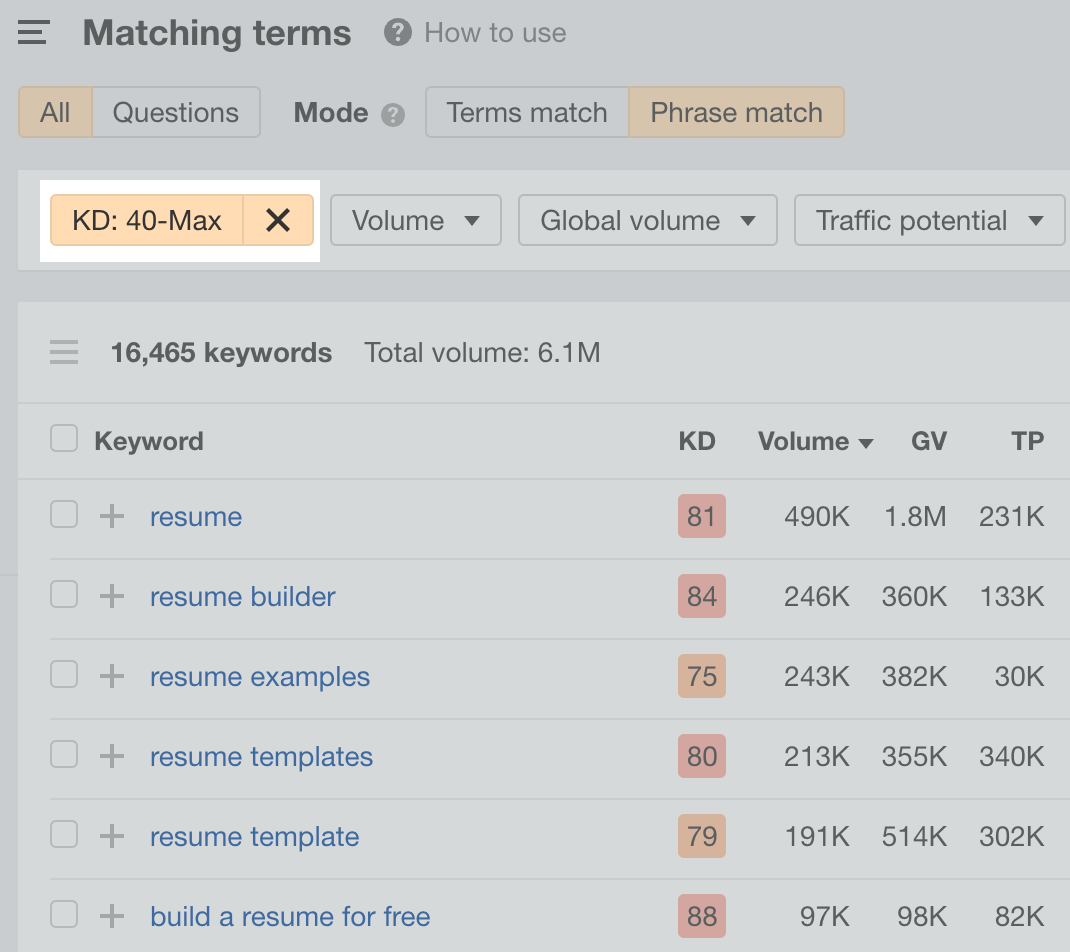
Why filter for KD?
The reason is due to the method we use at Ahrefs to calculate KD. Our KD score is calculated from a trimmed mean of referring domains (RDs) to the top 10 ranking pages.
In other words, the top-ranking pages for keywords with high KD scores have lots of backlinks on average.
From here, you’ll want to go through the report to find potential topics you could build a better piece of content around.
2. Make it better
The core idea (or assumption) behind the Skyscraper Technique is that people want to see the best.
Once you’ve found the content you want to beat, the next step is to make something even better.
According to Brian, there are four aspects worth improving:
- Length – If the post has 25 tips, list more.
- Freshness – Update any outdated parts of the original article with new images, screenshots, information, stats, etc.
- Design – Make it stand out with a custom design. You could even make it interactive.
- Depth – Don’t just list things. Fill in the details and make them actionable.
3. Reach out to the right people
The key to successfully executing the Skyscraper Technique is email outreach. But instead of spamming everyone you know, you reach out to those who have already linked to the specific content you have improved.
The assumption: Since they’ve already linked to a similar article, they’re more likely to link to one that’s better.
You can find these people by pasting the URL of the original piece into Ahrefs’ Site Explorer and then going to the Backlinks report.
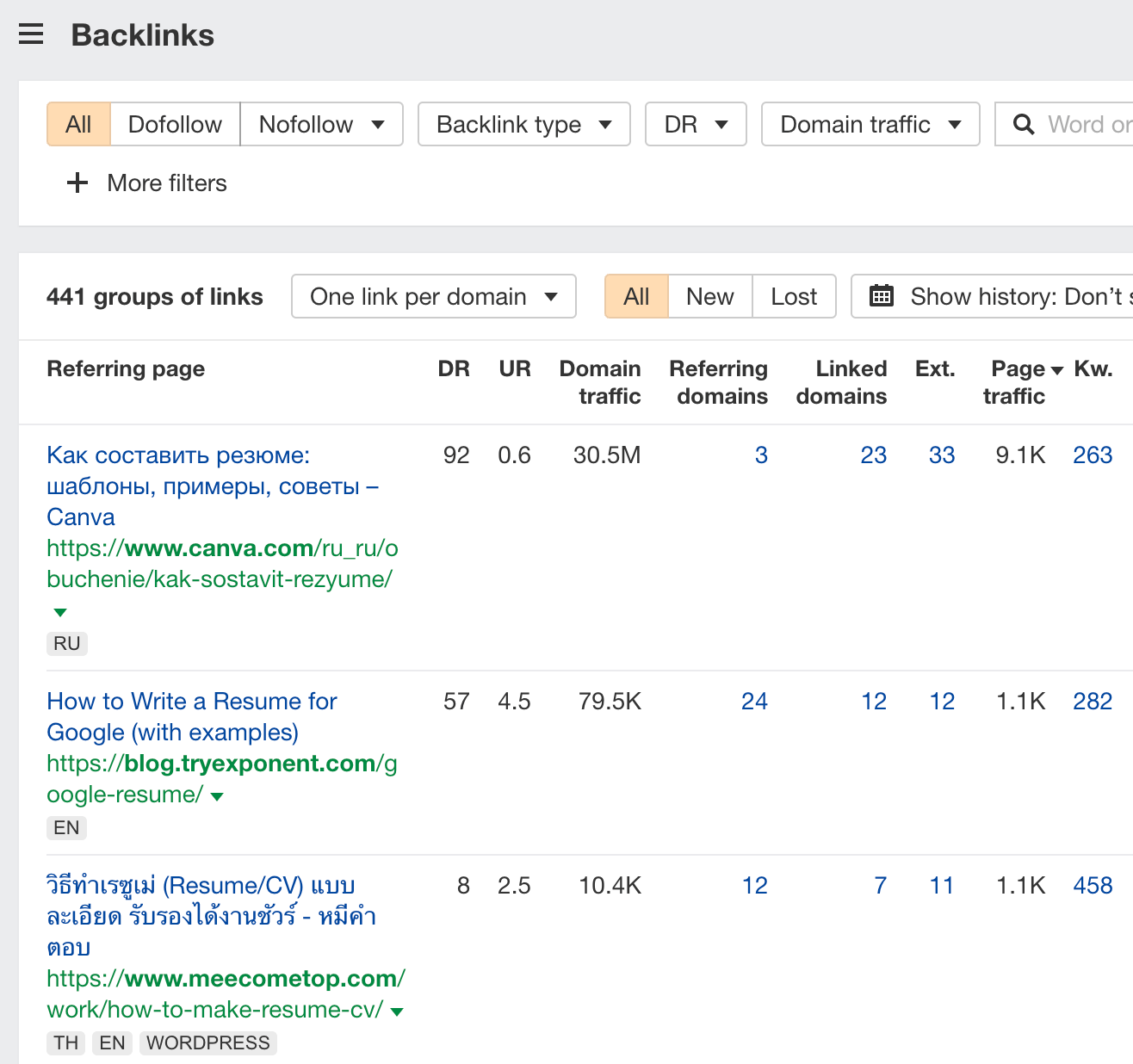
This report shows all the backlinks to the page. In this case, there are 441 groups of links.
But not all of these links will make good prospects. So you’ll likely need to add some filters to clean them up. For example, you can:
- Add a Language filter for the language you’re targeting (e.g., English).
- Switch the tab to Dofollow for equity-passing links.
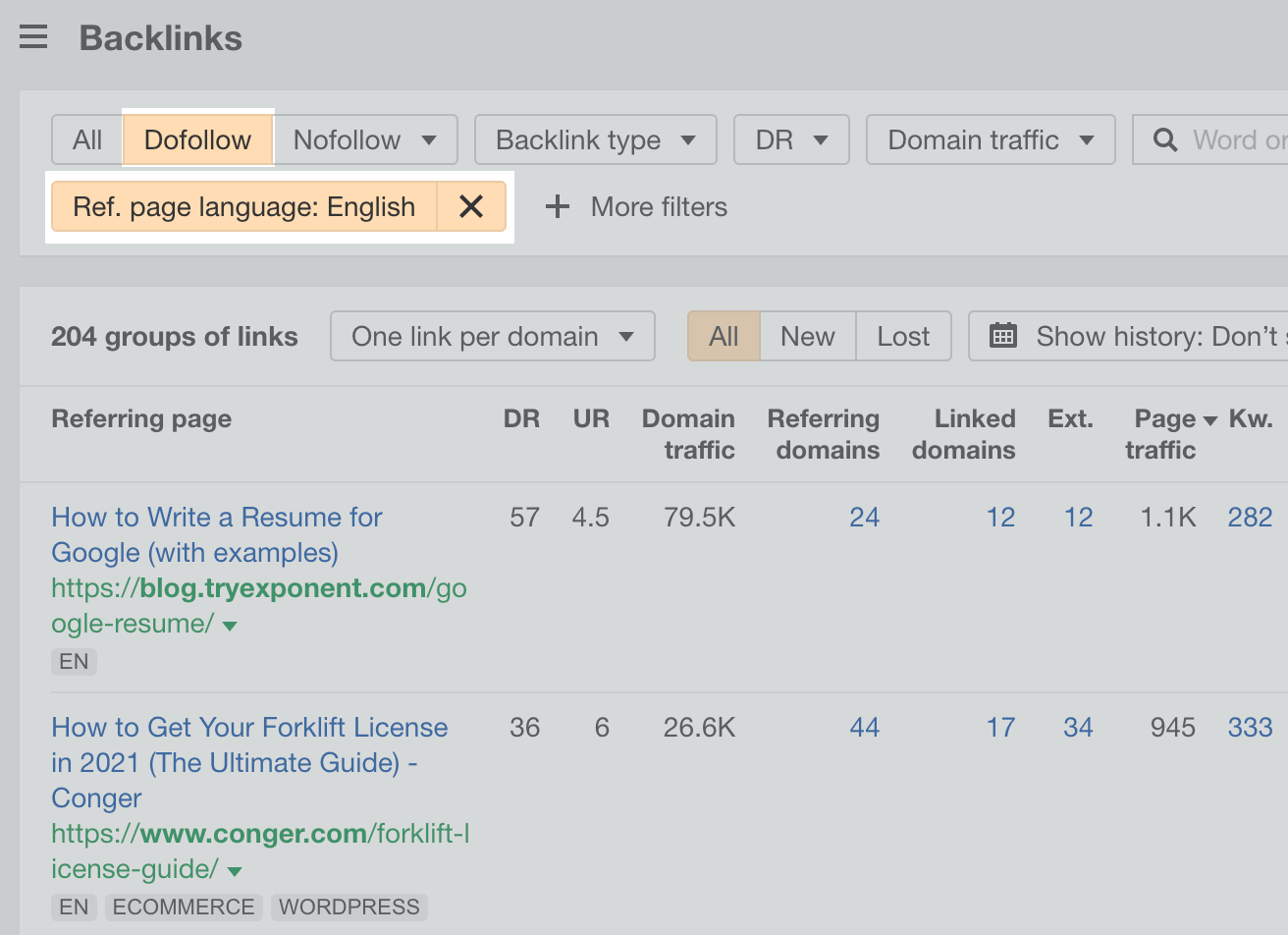
It’s been roughly eight years since Brian shared this link building strategy. Honestly speaking, the technique has been oversaturated. Given its widespread use, its effectiveness may even be limited.
Some SEOs even say they wouldn’t recommend it.
So we asked our Twitter and LinkedIn following this question and received 1,242 votes. Here are the results:

Clearly, many SEOs and marketers still believe the technique works.
Sidenote.
According to Aira’s annual State of Link Building report, only 18% of SEOs still use the Skyscraper Technique. It’s not a go-to for many SEOs, as it ranks #20 among the list of tactics. I suspect its popularity has waned because (1) it’s old and SEOs are looking for newer stuff and (2) SEOs believe that content is more important than links these days.
Fundamentally, it makes sense that the Skyscraper Technique still works. After all, the principles are the same behind (almost) any link building strategy:
- Create great content
- Reach out to people and promote it
But why do people think it’s no longer effective? There are a few reasons why and knowing them will help you improve your chances of success with the Skyscraper Technique.
Let’s start with:
1. Sending only Brian’s email template
In Brian’s original post, he suggested an email template for his readers to use:
Hey, I found your post: http://post1
<generic compliment>
It links to this post: http://post2
I made something better: http://post3
Please swap out the link for mine.
Unfortunately, many SEOs decided to use this exact template word for word.
Link building doesn’t exist in a vacuum. If everyone in your niche decides to send this exact template to every possible website, it’ll burn out real fast. And that’s exactly what happened.
Now, if a website owner sees this template, chances are they’ll delete it right away.
Sidenote.
Judging by my inbox, there are still people using this exact template. And, like everyone else, I delete the email immediately.
I’m not saying this to disparage templated emails. If you’re sending something at scale, templating is necessary. But move away from this template. Write your own, personalize it as much as possible, and follow the outreach principles here.
Even better, ask yourself:
“What makes my content unique and link-worthy?”
2. Not segmenting your prospects
People link for different reasons, so you shouldn’t send everyone the same pitch.
Consider dividing your list of prospects into segments according to the context in which they linked. You can do this by checking the Anchors report in Site Explorer.

You can clearly see people are linking to different statistics from our SEO statistics post. So, for example, if we were doing outreach for a hypothetical post, we might want to mention to the first group that we have a new statistic for “Over 90% of content gets no traffic from Google.”
Then, to the second group, we’ll mention that we have new statistics for “68% of online experiences.” And so on.
In fact, that’s exactly what we did when we built links to this post. Check out the case study here:
3. Not reaching out to enough people
Ultimately, link building is still a numbers game. If you don’t reach out to enough people, you won’t get enough links.
Simply put: You need to curate a larger list of link prospects.
So rather than limiting yourself to only replicating the backlinks of the original content, you should replicate the backlinks from other top-ranking pages covering the same topic too.
To find these pages, enter the target keyword into Keywords Explorer and scroll down to the SERP overview.
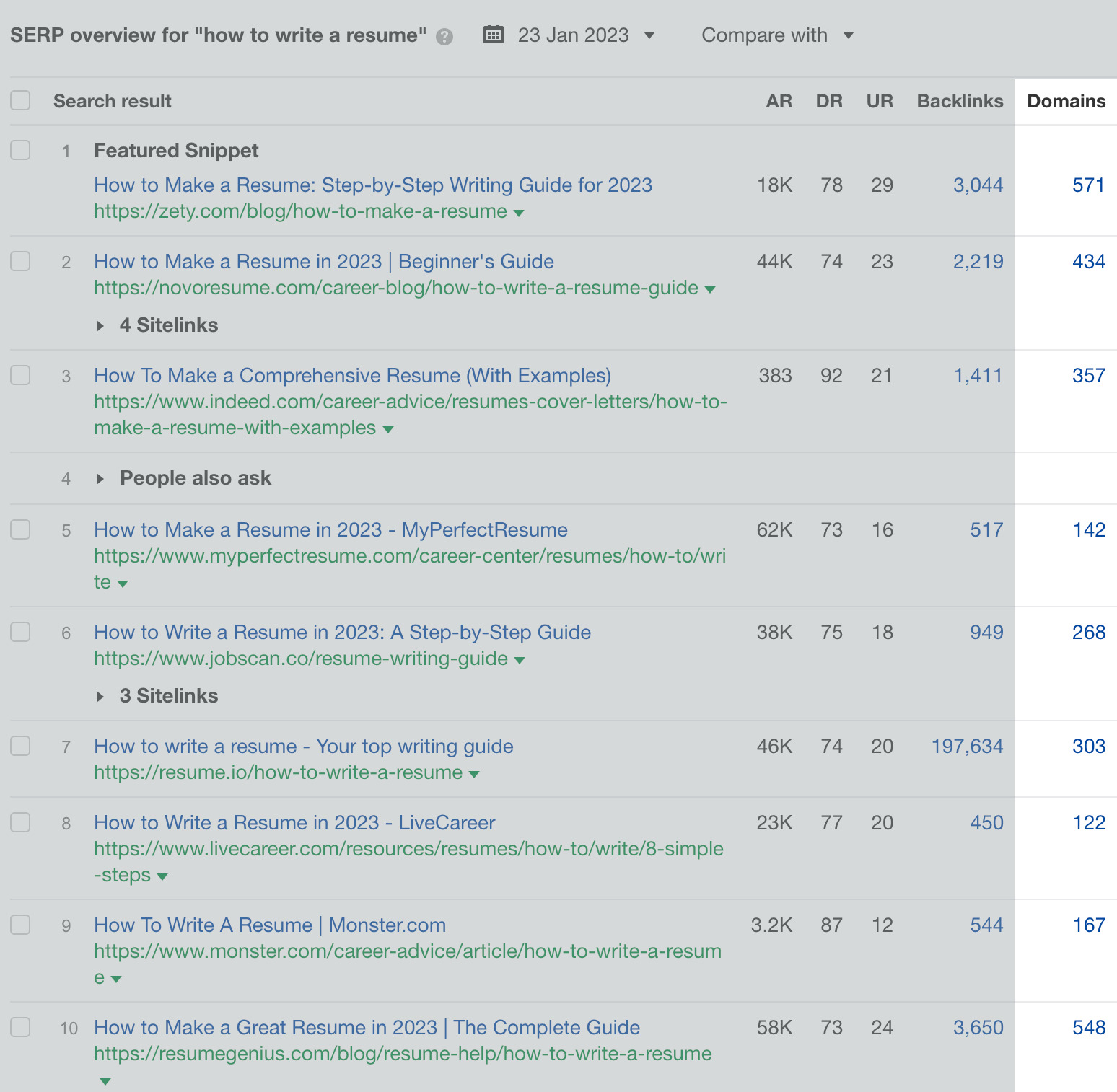
In this example, most top-ranking pages have tons of links, and all of them (after filtering, of course) could be potential link prospects.
Pro tip
Search for your keyword, set a Referring domains filter, and you’ll see relevant pages where you can “mine” for more skyscraper prospects.
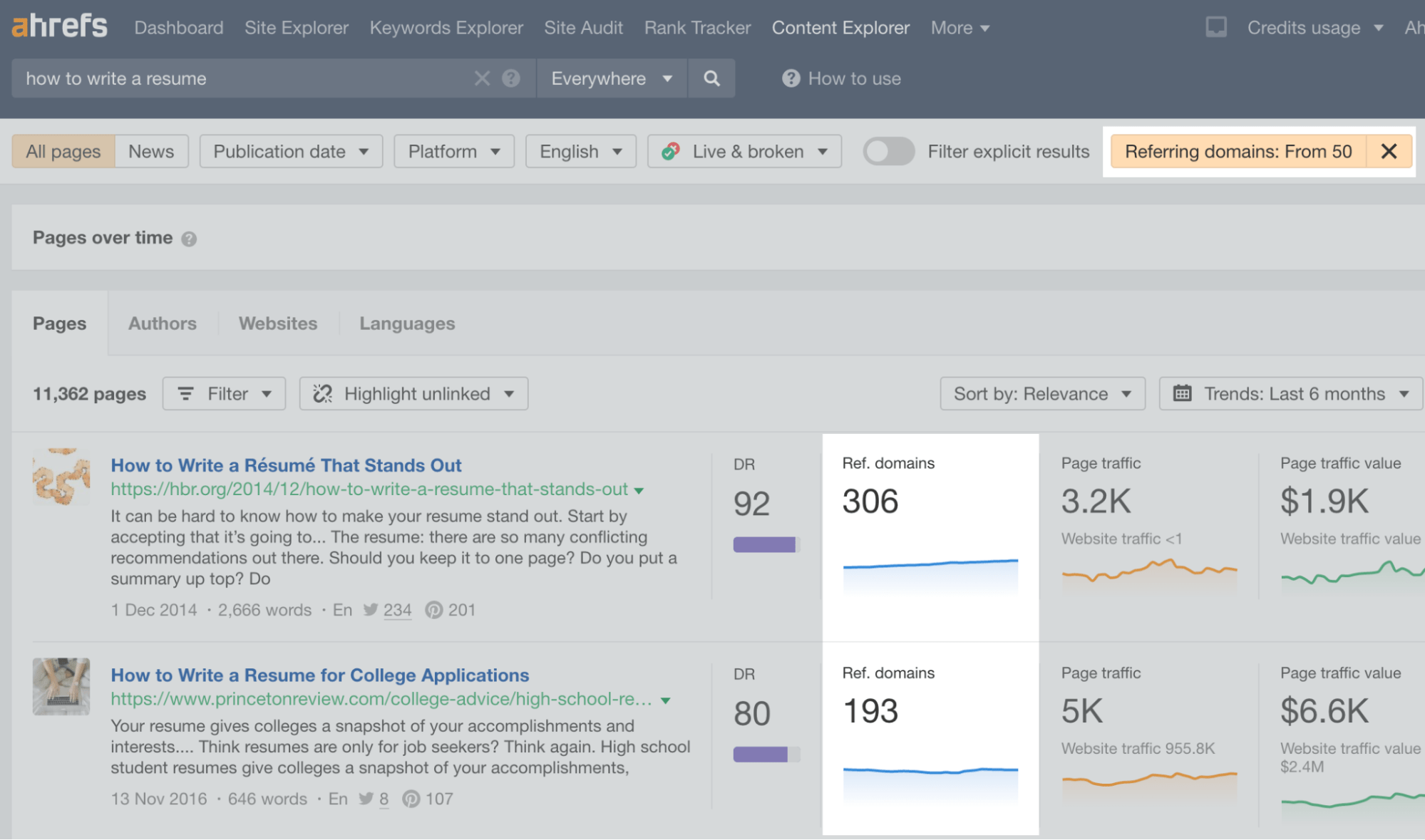
4. Thinking bigger equals better
Someone creates a list with 15 tools. The next person ups it to 30. Another “skyscrapers” it to 50, and the next increases it to 100.
Not only is it a never-ending arms race, there’s also no value for the reader.
No one wants to skim through 5,000 words or hundreds of items just to find what they need. Curation is where the value is.
When considering the four aspects mentioned by Brian, don’t improve things for the sake of improving them. Adding 25 mediocre tips to an existing list of 25 doesn’t make it “better.” Likewise for changing the publish date or adding a few low-quality illustrations.
Example: My colleague, Chris Haines, recently published a post on the best niche site ideas. Even though he only included 10, he has already outperformed the other “skyscraper” articles:
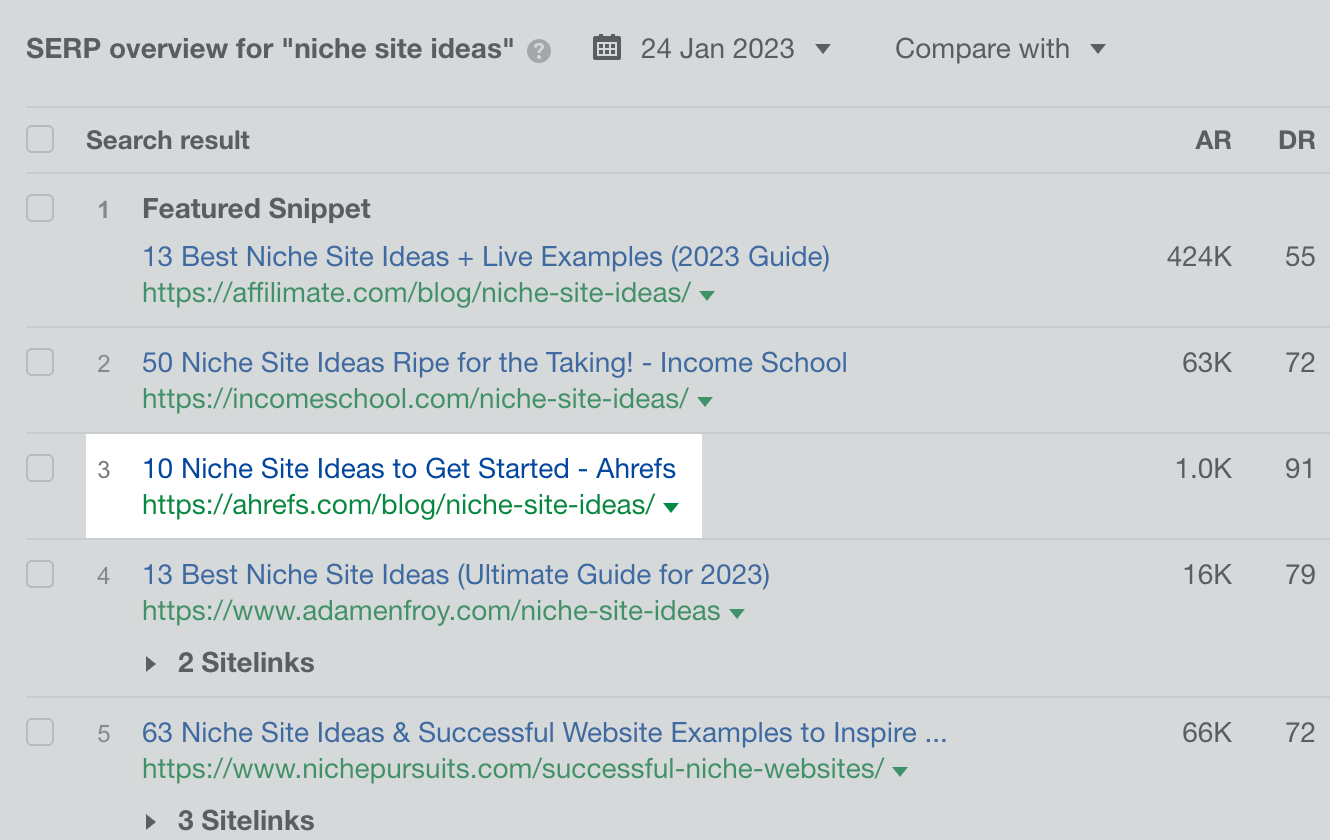
He differentiated himself through his knowledge and expertise. After all, Chris has 10 years of experience in SEO.
So when you’re creating your article, always look at any improvement through the lens of value:
Are you giving more value to the reader?
5. Not considering brand
As Ross Hudgens says, “Better does not occur in a branding vacuum.”
Most of the time, content isn’t judged solely on its quality. It’s also judged by who it comes from. We discovered this ourselves too when we tried to build links to our keyword research guide.
Most of the time, people didn’t read the article. They linked to us because of our brand and reputation—they knew we were publishing great content consistently, and they had confidence that the article we were pitching was great too.
In other words, there are times where no matter how hard you “skyscraper” your content, people just won’t link to it because they don’t know who you are.
Having your own personal brand is important these days. But think about it: What is a “strong brand” if not a consistent output of high-quality work that people enjoy? One lone skyscraper doesn’t make a city; many of them together do.
What I’m saying is this: Don’t be discouraged if your “skyscraper” article gets no results. And don’t be discouraged just because you don’t have a brand right now—you can work on that over time.
Keep on making great content—skyscraper or not—and results will come if you trust the process.
“Rome wasn’t built in a day, but they were laying bricks every hour.”
Final thoughts
The Skyscraper Technique is a legitimate link building tactic that works. But that can only happen if you:
Any questions or comments? Let me know on Twitter.
SEO
Google Declares It The “Gemini Era” As Revenue Grows 15%

Alphabet Inc., Google’s parent company, announced its first quarter 2024 financial results today.
While Google reported double-digit growth in key revenue areas, the focus was on its AI developments, dubbed the “Gemini era” by CEO Sundar Pichai.
The Numbers: 15% Revenue Growth, Operating Margins Expand
Alphabet reported Q1 revenues of $80.5 billion, a 15% increase year-over-year, exceeding Wall Street’s projections.
Net income was $23.7 billion, with diluted earnings per share of $1.89. Operating margins expanded to 32%, up from 25% in the prior year.
Ruth Porat, Alphabet’s President and CFO, stated:
“Our strong financial results reflect revenue strength across the company and ongoing efforts to durably reengineer our cost base.”
Google’s core advertising units, such as Search and YouTube, drove growth. Google advertising revenues hit $61.7 billion for the quarter.
The Cloud division also maintained momentum, with revenues of $9.6 billion, up 28% year-over-year.
Pichai highlighted that YouTube and Cloud are expected to exit 2024 at a combined $100 billion annual revenue run rate.
Generative AI Integration in Search
Google experimented with AI-powered features in Search Labs before recently introducing AI overviews into the main search results page.
Regarding the gradual rollout, Pichai states:
“We are being measured in how we do this, focusing on areas where gen AI can improve the Search experience, while also prioritizing traffic to websites and merchants.”
Pichai reports that Google’s generative AI features have answered over a billion queries already:
“We’ve already served billions of queries with our generative AI features. It’s enabling people to access new information, to ask questions in new ways, and to ask more complex questions.”
Google reports increased Search usage and user satisfaction among those interacting with the new AI overview results.
The company also highlighted its “Circle to Search” feature on Android, which allows users to circle objects on their screen or in videos to get instant AI-powered answers via Google Lens.
Reorganizing For The “Gemini Era”
As part of the AI roadmap, Alphabet is consolidating all teams building AI models under the Google DeepMind umbrella.
Pichai revealed that, through hardware and software improvements, the company has reduced machine costs associated with its generative AI search results by 80% over the past year.
He states:
“Our data centers are some of the most high-performing, secure, reliable and efficient in the world. We’ve developed new AI models and algorithms that are more than one hundred times more efficient than they were 18 months ago.
How Will Google Make Money With AI?
Alphabet sees opportunities to monetize AI through its advertising products, Cloud offerings, and subscription services.
Google is integrating Gemini into ad products like Performance Max. The company’s Cloud division is bringing “the best of Google AI” to enterprise customers worldwide.
Google One, the company’s subscription service, surpassed 100 million paid subscribers in Q1 and introduced a new premium plan featuring advanced generative AI capabilities powered by Gemini models.
Future Outlook
Pichai outlined six key advantages positioning Alphabet to lead the “next wave of AI innovation”:
- Research leadership in AI breakthroughs like the multimodal Gemini model
- Robust AI infrastructure and custom TPU chips
- Integrating generative AI into Search to enhance the user experience
- A global product footprint reaching billions
- Streamlined teams and improved execution velocity
- Multiple revenue streams to monetize AI through advertising and cloud
With upcoming events like Google I/O and Google Marketing Live, the company is expected to share further updates on its AI initiatives and product roadmap.
Featured Image: Sergei Elagin/Shutterstock
SEO
brightonSEO Live Blog

Hello everyone. It’s April again, so I’m back in Brighton for another two days of Being the introvert I am, my idea of fun isn’t hanging around our booth all day explaining we’ve run out of t-shirts (seriously, you need to be fast if you want swag!). So I decided to do something useful and live-blog the event instead.
Follow below for talk takeaways and (very) mildly humorous commentary. sun, sea, and SEO!
SEO
Google Further Postpones Third-Party Cookie Deprecation In Chrome

Google has again delayed its plan to phase out third-party cookies in the Chrome web browser. The latest postponement comes after ongoing challenges in reconciling feedback from industry stakeholders and regulators.
The announcement was made in Google and the UK’s Competition and Markets Authority (CMA) joint quarterly report on the Privacy Sandbox initiative, scheduled for release on April 26.
Chrome’s Third-Party Cookie Phaseout Pushed To 2025
Google states it “will not complete third-party cookie deprecation during the second half of Q4” this year as planned.
Instead, the tech giant aims to begin deprecating third-party cookies in Chrome “starting early next year,” assuming an agreement can be reached with the CMA and the UK’s Information Commissioner’s Office (ICO).
The statement reads:
“We recognize that there are ongoing challenges related to reconciling divergent feedback from the industry, regulators and developers, and will continue to engage closely with the entire ecosystem. It’s also critical that the CMA has sufficient time to review all evidence, including results from industry tests, which the CMA has asked market participants to provide by the end of June.”
Continued Engagement With Regulators
Google reiterated its commitment to “engaging closely with the CMA and ICO” throughout the process and hopes to conclude discussions this year.
This marks the third delay to Google’s plan to deprecate third-party cookies, initially aiming for a Q3 2023 phaseout before pushing it back to late 2024.
The postponements reflect the challenges in transitioning away from cross-site user tracking while balancing privacy and advertiser interests.
Transition Period & Impact
In January, Chrome began restricting third-party cookie access for 1% of users globally. This percentage was expected to gradually increase until 100% of users were covered by Q3 2024.
However, the latest delay gives websites and services more time to migrate away from third-party cookie dependencies through Google’s limited “deprecation trials” program.
The trials offer temporary cookie access extensions until December 27, 2024, for non-advertising use cases that can demonstrate direct user impact and functional breakage.
While easing the transition, the trials have strict eligibility rules. Advertising-related services are ineligible, and origins matching known ad-related domains are rejected.
Google states the program aims to address functional issues rather than relieve general data collection inconveniences.
Publisher & Advertiser Implications
The repeated delays highlight the potential disruption for digital publishers and advertisers relying on third-party cookie tracking.
Industry groups have raised concerns that restricting cross-site tracking could push websites toward more opaque privacy-invasive practices.
However, privacy advocates view the phaseout as crucial in preventing covert user profiling across the web.
With the latest postponement, all parties have more time to prepare for the eventual loss of third-party cookies and adopt Google’s proposed Privacy Sandbox APIs as replacements.
Featured Image: Novikov Aleksey/Shutterstock
-

 PPC7 days ago
PPC7 days ago19 Best SEO Tools in 2024 (For Every Use Case)
-
SEARCHENGINES6 days ago
Daily Search Forum Recap: April 19, 2024
-

 WORDPRESS7 days ago
WORDPRESS7 days agoHow to Make $5000 of Passive Income Every Month in WordPress
-

 MARKETING6 days ago
MARKETING6 days agoBattling for Attention in the 2024 Election Year Media Frenzy
-

 WORDPRESS5 days ago
WORDPRESS5 days ago13 Best HubSpot Alternatives for 2024 (Free + Paid)
-

 SEO7 days ago
SEO7 days ago25 WordPress Alternatives Best For SEO
-

 WORDPRESS6 days ago
WORDPRESS6 days ago7 Best WooCommerce Points and Rewards Plugins (Free & Paid)
-

 MARKETING7 days ago
MARKETING7 days agoTinuiti Marketing Analytics Recognized by Forrester
















You must be logged in to post a comment Login